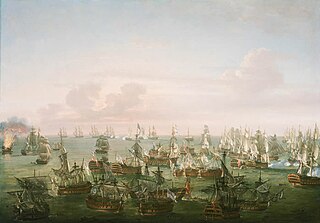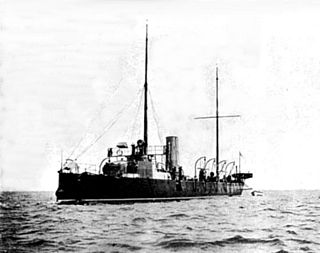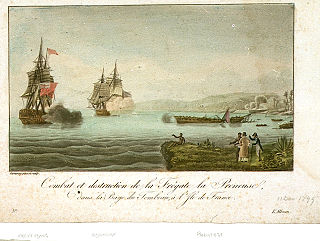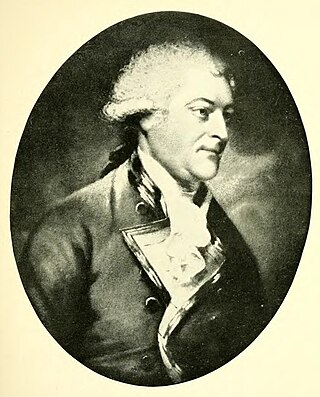
HMS Mars was a 74-gun third-rate ship of the line of the Royal Navy, launched on 25 October 1794 at Deptford Dockyard.

The second Hancock was one of the first thirteen frigates of the Continental Navy. A resolution of the Continental Congress dated 13 December 1775 authorized her construction; she was named for the patriot and Continental congressman John Hancock. In her career, she served under the American, British and French flags.

HMS Rattlesnake was an Atholl-class 28-gun sixth-rate corvette of the Royal Navy launched in 1822. She made a historic voyage of discovery to the Cape York and Torres Strait areas of northern Australia.

HMS St Lawrence was a 102-gun first-rate wooden warship of the Royal Navy that served on Lake Ontario during the War of 1812. Built on the lake at the Royal Navy dockyard in Kingston, Ontario, she was the only Royal Navy ship of the line ever to be launched and operated entirely in fresh water. Constructed in 1814, the ship's arrival on the lake ended all naval action and St Lawrence finished the war having never gone into battle. Following the war, the vessel was laid up, eventually being sold in 1832 to private interests. The ship later sank and is now a recreational dive spot.

HMS Bristol was a 50-gun Portland-class fourth-rate ship of the line, built for the Royal Navy in the 1770s. She served as a flagship during the Battle of Sullivan's Island, Charleston, South Carolina in 1776 during the American Revolutionary War and later participated in the 1783 Battle of Cuddalore during the Anglo-French War of 1778–83. By 1787 the ship had been converted into a church ship. Converted into a prison ship in 1794, Bristol instead served as a hospital ship until she was broken up in 1810.
HMS Zebra was the first ship to bear the name in the British Navy. She was a 14 gun ship sloop of the Swan class, launched on 8 April 1777. She was abandoned and blown up after going aground on 22 October 1778 at Little Egg Harbor, New Jersey, during the American Revolutionary War after only one year in service.
USS Rattlesnake was the brig Rambler built in Medford, Massachusetts, in 1812 that the United States Navy purchased in July 1813. Rattlesnake captured numerous British merchant vessels before HMS Leander captured her in mid-1814. The Royal Navy apparently purchased her at Nova Scotia, but there is no record of her subsequent career.

HMS Conqueror was a 101-gun Conqueror-class screw-propelled first-rate ship of the line of the Royal Navy. She was launched in 1855, but spent only six years in service before being wrecked on Rum Cay in what was then the colony of the Bahamas in 1861.

HMS Cerberus was a 28 gun sixth-rate frigate of the Royal Navy.

Vice-Admiral Thomas Pringle was a British officer of the Royal Navy. He served during the American War of Independence, and the French Revolutionary and Napoleonic Wars.

HMS Winchelsea was a 32-gun fifth-rate Niger-class frigate of the Royal Navy, and was the sixth Royal Navy ship to bear this name. She was ordered during the Seven Years' War, but completed too late for that conflict. She cost £11,515-18-0d to build.

HMS Rattlesnake was a unique design of torpedo gunboat of the Royal Navy. A result of the Russian war scare of 1885, she was designed by Nathaniel Barnaby that year and built by Laird Brothers, of Birkenhead. Quickly made obsolete by the new torpedo boat destroyers, she became an experimental submarine target ship in 1906, and was sold in 1910.

HMS Adamant was a 50-gun Portland-class fourth rate warship of the British Royal Navy. She served during the American War of Independence, the French Revolutionary Wars, and the Napoleonic Wars in a career that spanned thirty years.
HMS Swift has been the name of numerous ships of the Royal Navy:

HMS Mediator was a Roebuck-class 44-gun fifth rate of the Royal Navy. She was built and served during the American War of Independence, but was reduced to a storeship and renamed HMS Camel in 1788. She spent the French Revolutionary and part of the Napoleonic Wars in this capacity before being broken up in 1810.

John Bastard of Sharpham, Ashprington, Devon, was an officer of the Royal Navy who saw service during the French Revolutionary and Napoleonic Wars, and the War of 1812, rising to the rank of post-captain. He also entered politics and became a Member of Parliament.

Admiral Robert Linzee was an officer of the Royal Navy who served during the American War of Independence, and the French Revolutionary and Napoleonic Wars.

HMS Vulture was a 14 to 16-gun ship sloop of the Swan class, launched for the Royal Navy on 18 March 1776. She served during both the American Revolutionary War and the French Revolutionary War, before the Navy sold her in 1802. Vulture is perhaps best known for being the warship to which Benedict Arnold fled on the Hudson River in 1780 after unsuccessfully trying to betray the Continental Army's fortress at West Point, New York to the British.

HMS Atalanta was a 14 gun ship sloop of the Swan class, launched on 12 August 1775. She served during the American Revolutionary War. On 28 May 1781, Atlanta was engaged by the privateer Alliance, in which 24 crew were killed or wounded. In May 1782, under the command of Brett, she destroyed an American privateer, under then command of Ayret, near Cape d'Or. Privateers from Cumberland were on board. The privateers escaped to the woods leaving their provisions, which Captain Brett took to Cumberland.

HMS Pegasus was a 14-gun ship sloop of the Swan class, launched on 27 December 1776. She was commissioned the same month under Commander John Hamilton Gore and - after completing on 3 March 1777 - sailed for Newfoundland on 3 April. She was lost with all hands in a storm off Newfoundland in October.

















